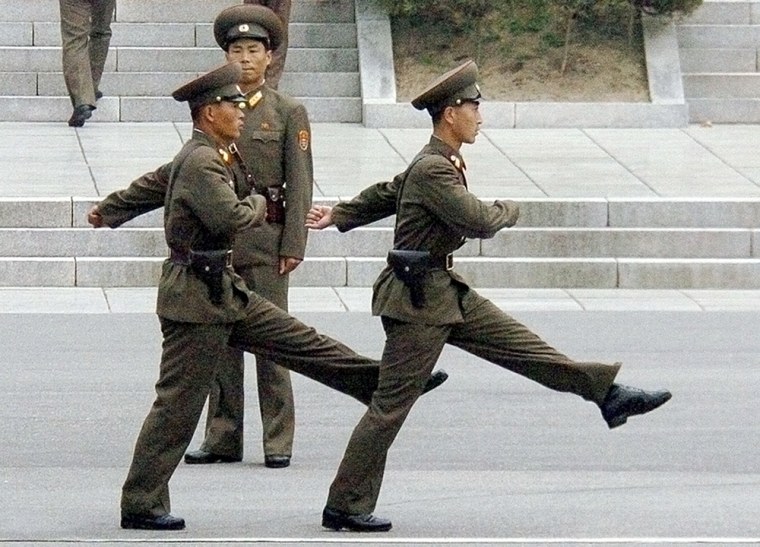North Korean troops in the Demilitarized Zone dividing the two Koreas have been more boldly trying to provoke guards on the other side since Pyongyang claimed to have detonated a nuclear bomb, a U.S. military spokesman said Wednesday.
The North Koreans have stepped up their usual attempts to needle their South Korean counterparts: spitting across the demarcation line, making throat-slashing hand gestures, flashing their middle finger and trying to talk to the troops, said Army Major Jose DeVarona of Fayetteville, N.C.
“They’re walking a little taller,” said DeVarona told reporters during a tour of the zone, adding that the overall situation was calm. “They’re more confident about making contact.”
North and South Korean soldiers face each other in the village of Panmunjom, a cluster of blue buildings inside the 2.5-mile-wide, 156-mile-long buffer strip. About 200 U.S. troops are also stationed along the DMZ.
The DMZ is one of the world’s most potentially dangerous flashpoints, but Panmunjom is also a tourist trap where buses disgorge thousands of visitors each year who come to gawk at the North Korean soldiers. The village is jointly overseen by the U.S.-led U.N. Command and North Korea, an arrangement established in 1953 to supervise the cease-fire that ended the 1950-53 Korean War.
North Korean troops were not seen engaging in provocative antics during the reporters’ tour.
Brief meeting at DMZ
Seven North Korean soldiers, wearing olive green uniforms and tall, round-brimmed hats, guarded U.N. buildings where meetings between the two sides are sometimes held.
South Korean soldiers in black helmets and sunglasses stood in their traditional pose: legs wide apart in a martial-arts stance with arms at their sides, fists tightly clenched and ready to strike.
At one point, two North Korean officers marched to the line and faced a large group of TV cameramen and photographers. They stood for about 10 minutes, staring blankly at the cameras, before marching away.
About 20 minutes later, the officers returned with the soldiers, who marched behind them, swinging their arms high across their body in unison. They had a brief meeting with their U.S. and U.N. counterparts at the demarcation line.
U.S. Navy Lt. Comm. Chris Dignan told reporters the meeting was about repatriating the body of a North Korean soldier who washed up in the South’s territorial waters last month. Officials did not give the cause of his death, but DeVarona said bodies routinely wash up after flooding in the North.
Before the tour, U.S. soldiers — among the 29,500 stationed throughout South Korea — gave standard orders not to make gestures, point at or try to talk to the North Koreans.
'As if they’re victorious'
U.S. Army Capt. Craig Cunningham, who serves at an observation post where tourists can peer into North Korea, said American troops weren’t worried about the recent tensions blowing up into a war.
He said the situation along the border was relatively calm, considering the two sides fought a devastating war and share the world’s most heavily armed border.
The DMZ has been the site of numerous infiltrations and violent confrontations over the decades, but such incidents have diminished in recent years, Cunningham said. He noted that the two Koreas have been holding a series of meetings and have set up a joint economic zone run by both sides.
“Looking back in history this has been as friendly as you can get,” said Cunningham, of El Paso, Texas. “Looking at the overall perspective, this is the calmest it has ever been.”
Swedish Maj. Gen. Theolin Sture, who was on a two-year tour for the United Nations, said he’s visited the North Korean side of the border and it seemed more relaxed.
“They behave as if they’re victorious: ’We won the war and this is what it looks like,”’ Sture said.
